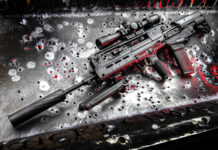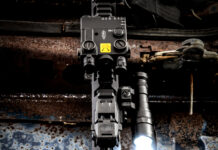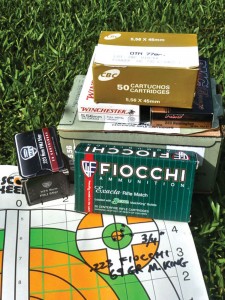
Rounding it all out, the Texas Rifle was Cerakoted in an attractive and durable Barrett Bronze, though Magpul FDE and Burnt Bronze are also available. Weighing in at 7.6 pounds, the rifle came in a lockable hard case with one 20-round metal magazine.
In case you have not caught on yet, RRA makes a lot of proprietary stuff for their ARs. Among these are their Operator CAR buttstock and Star safety selector, both of which are found on the Texas Rifle. While arguably mundane as some AR parts go, they are nevertheless significant. In an age where we have multiple choices of excellent, reasonably priced AR stocks from many makers, the vintage (cheap) 6-position military CAR stocks seen on many ARs are, at best, merely adequate. Thankfully, RRA did not skimp on the Texas Rifle in this regard. The RRA Operator CAR stock is similar to the highly regarded LMT SOPMOD stock, with a rubber butt pad and flared sides for an improved cheek-weld, each containing compartments for batteries or other items. It also has two ambidextrous QD sling-swivel recepticles, one in the normal spot centered near the rear of the stock, another near the forward end for use with a single-point sling. It also has a rubber butt pad that has raised horizontal ridges along its length that help keep the weapon in the shoulder pocket without shifting. I like it a lot.
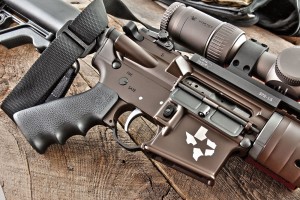
The RRA Star Safety features a raised, serrated half-dome button on the end nearest the thumb. I have heard it referred to as a “tactical nipple,” but whatever you call it, it’s very effective. It is easy to appreciate when your hands are sweaty or you are wearing gloves and need to operate the safety quickly, especially when it may be a little stiff. It’s about the best ten dollar AR-upgrade you’ll find.
While the Texas Rifle does not come with back up iron sights, On Target’s Editor, Ben Battles, did equip my test rifle with a Vortex Razor HD Gen II 1-6X24mm riflescope with a JM-1 BDC reticle ($1,999; www.vortexoptics.com) before shipping it down to me. This scope has enough features in itself to be worthy of its own article, but I will hit the high points here. Designed with the input of the legendary Jerry Miculek, the Razor features a machined-aluminum 10.1 inch, 30mm FDE painted tube that is water, fog and shockproof. A second focal plane scope, the BDC-type reticle retains constant size magnification is increased. The BDC has holdovers with gradients out to 600 meters below the horizontal crosshair. The center cross-hair also features a small red dot illuminated by a CR2032 battery that has 11 intensity levels. The large, well-made turrets provide positive 1/4 MOA adjustments, but do not have a zero-stop feature like other Vortex models with higher magnification. The 24mm Razor is super clear, exceptionally bright and very easy to keep parallax free thanks to the coated lenses and a bunch of other optical features that are way above my technical pay grade to explain. The Vortex I used came on a Larue M4 LT104 SPR-E QD mount, which is arguably the best mount you can get for this type of optic. It mounts quickly, retains zero as if welded to the gun, and comes off just as easily. In the end, it’s not cheap, but the Vortex Razor is at least as good, and maybe better, than similar but more expensive scopes from other high-end manufacturers.
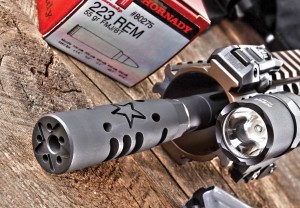
The Texas Rifle could serve well in any application for which you may choose to use an AR, but with its design and wearing a Vortex scope it practically screams one thing: Three-gun competition! I have been shooting three-gun at local matches for a while now, so I had some idea of how to put the rifle through its paces. With this in mind, I went to the range with some friends on a sunny, 98-degree North Carolina day, complemented by the typical 95% humidity and punctuated with a few mild breezes to help keep us from melting. I started by conducting accuracy tests from the bench at 100 yards utilizing my old-school Molle daypack as a rest, and feeding five different 5.56/.223 loads of 55, 62, 69 and 77 grains respectively. Between the rifle, scope, ammo, expedient rest and my shooting ability as a typical Earthling, I hoped to meet the Texas Rifle’s advertised level of 3/4 MOA accuracy. I was not disappointed. Most loads averaged around 1.75 inches, with many of the best four of five rounds inside an inch for groups fired on Champion Score Keeper rifle targets. Generally, the Texas Rifle seemed to prefer the heavier loads, with the best coming from Fiocchi’s 69-gr. Sierra Matchking Exacta load, which turned out a tight 0.75” group. This kind of accuracy is more than adequate for most three-gun engagements, the majority of which are inside 75 yards, with some longer shots out to or even past 200 yards. Satisfied, I moved on to three-gun style shooting inside 50 yards, setting up multiple cardboard IDPA targets and one nine inch swinging steel circle stop plate. Shooting from various static positions and while moving, I had no problem making rapid, center hits on all the targets despite my unrated skill level. I was significantly aided by the highly effective combination of the scope, muzzle brake, stock and 2-stage trigger.
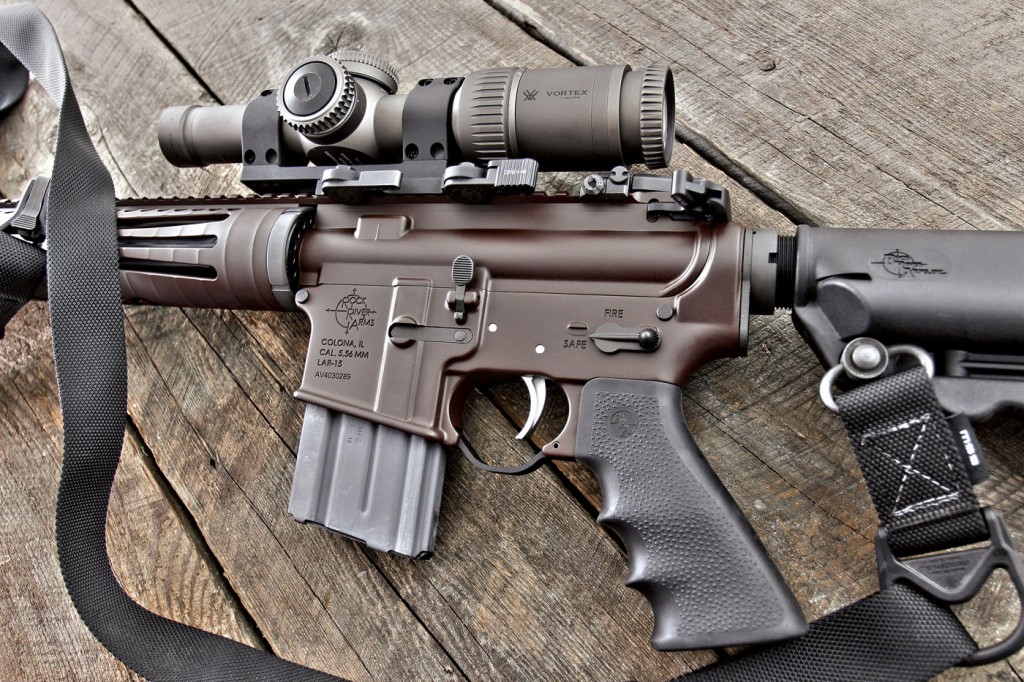 Equally important, the Texas Rifle was entirely reliable throughout testing, going through over 300 rounds of various types of 5.56 and .223 ammo with no hiccups of any kind. About the only issue I noted (a very minor one) was the fact that PMAGs and MSAR standard-capacity magazines would not drop free easily from the mag well, though Lancer, Troy and standard metal military mags worked fine.
Equally important, the Texas Rifle was entirely reliable throughout testing, going through over 300 rounds of various types of 5.56 and .223 ammo with no hiccups of any kind. About the only issue I noted (a very minor one) was the fact that PMAGs and MSAR standard-capacity magazines would not drop free easily from the mag well, though Lancer, Troy and standard metal military mags worked fine.
You don’t have to be from or even like Texas to appreciate RRAs Texas Rifle. It was with sad regret that I had to send it and its accompanying Vortex Razor HD II on their journey back home. With an MSRP of $1,700, the Texas Rifle is not the cheapest AR out there, but it has all the custom features you could want and pay considerably more to get from other makers. It can more than hold its own with any other AR out there, particularly in the worlds of competition shooting or varmint hunting. The same is true of the Vortex Razor HD II 1-6×24 scope, one of which I will be acquiring as soon as I can earn, borrow or sell enough to buy one for my own three-gun AR. See the Texas Rifle at your gun shop, or contact Rock River Arms, Dept. OT; Tel.: (866) 980-ROCK; Web: www.rockriverarms.com










